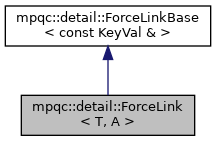•All Classes Namespaces Files Functions Variables Typedefs Enumerations Enumerator Friends Macros Modules Pages
Search Results
mpqc::detail::ForceLink< T, A > Class Template Reference
Collaboration diagram for mpqc::detail::ForceLink< T, A >:

Documentation
template<class T, class A = const KeyVal&>
class mpqc::detail::ForceLink< T, A >
This, together with ForceLinkBase, is used to force code for particular classes to be linked into executables.
Public Member Functions | |
| ForceLink () | |
| virtual ~ForceLink () | |
| DescribedClass * create (A a) | |
 Public Member Functions inherited from mpqc::detail::ForceLinkBase< const KeyVal & > Public Member Functions inherited from mpqc::detail::ForceLinkBase< const KeyVal & > | |
| ForceLinkBase () | |
| virtual ~ForceLinkBase () | |
| virtual DescribedClass * create (const KeyVal &)=0 | |
Constructor & Destructor Documentation
◆ ForceLink()
template<class T , class A = const KeyVal&>
|
inline |
◆ ~ForceLink()
template<class T , class A = const KeyVal&>
|
inlinevirtual |
Member Function Documentation
◆ create()
template<class T , class A = const KeyVal&>
| DescribedClass* mpqc::detail::ForceLink< T, A >::create | ( | A | a | ) |
The documentation for this class was generated from the following file:
- mpqc/util/keyval/forcelink.h
 1.8.20
1.8.20